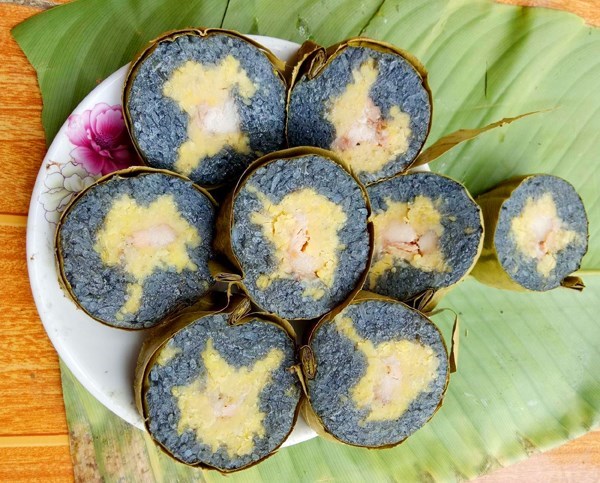Black sticky rice cakes: Special treat of Tay ethnic in Lunar New Year
 Black sticky rice cakes (Photo: Vietnam+)
Black sticky rice cakes (Photo: Vietnam+)Hanoi (VNA) - As well as being a delicious dish, the black sticky rice cake is a cultural symbol of the locality.
The black cakes are made of local Cam Duong sticky rice, green bean, fresh pork, dong leaves, spices and powder from the burnt flour of nuc nac (Indian trumpet flower), which bring the black colour for the cake.
Locals gather nuc nac plant, dry it, burn it and pound it to get a black powder. The powder is then mixed with the sticky rice, which is then used to make the cake.
Hoang Thi Nhu, a Tay ethnic woman in Na Hoi commune, Bac Ha District, Lao Cai province said that the wood firing process requires a close watch on the temperature of the fire. The ashes are then crushed into powder and mixed with glutinous rice to turn it into black. The rice is pounded and then winnowed.
The nuc nac powder has anti-biotic and anti-inflammation features among other good usages that make it a popular herbal medicine.
Nuc nac powder helps the black sticky cakes stay fresh for 7-10 days at room temperature in winter and 3-5 days in summer.
The cylindrical hand length cake is stuffed with pork, pepper, mung bean, and black cardamom.
Tay people wrap the inside of the cake on dong leaves in a square, round, or cylinder form. The cake is boiled for between 10 to 12 hours. When the cakes are cooked, the sticky rice smells good with the yellow-green beans inside, fatty pork, pepper and the smell of dong leave and the fragrance of nuc nac plant.
According to folk culture researchers, in the past, there was a salt scarcity in the northwestern region.
The ancestors of today’s Tay ethnic group went to the forest and chopped down a kind of tree called the 'salt tree' to bring home. They took the bark of the tree, dried it and burnt it to coal. They used that kind of coal in cooking instead of sea salt. The black colour in sticky rice was created by the coal powder from that tree.
When it is cooked, the cake has a salty flavour and a little smell of wild plants. Besides the salt tree, Tay people also use cay gun (a local wild plant) or co chanh (grass with the smell of lime) and burn them to make coal powder for making the cake.
According to cultural researchers, the way to wrap the black cake features a yin-yang balance.
Tay people think heaven is round while the earth is square, which is expressed in the form of the cake: a round body and both ends in square form.
Yin-yang features are also found in the way they use the dong leaves, with two placed at two different sides and ends facing each other. The number of bamboo strings used to tie the cake is an odd number, either five or nine.
When giving one another the cakes as a gift, they always give them in a pair to create a harmony of yin and yang.
When they tie up the bamboo string, Tay people tie it in a spiral. One bamboo string is tied above another one, which holds the cake firmly inside the leaves while the sticky rice swells inside in the heat.
When the cake is well cooked, locals use bamboo to cut the cake into many small pieces.
Besides boiled black cake, people may also bake cakes by putting them on coal till the insides smell good.
The cake used to be made only for traditional Tet festival, but now it is produced all year round as a specialty and souvenir for visitors./.












